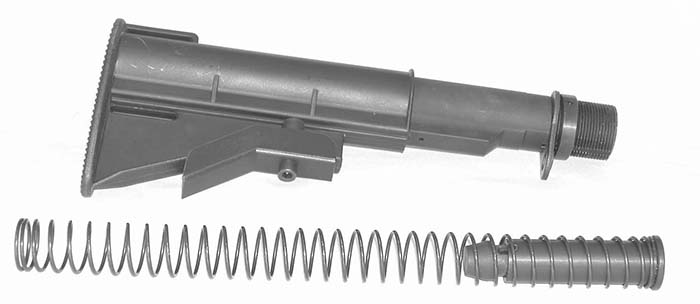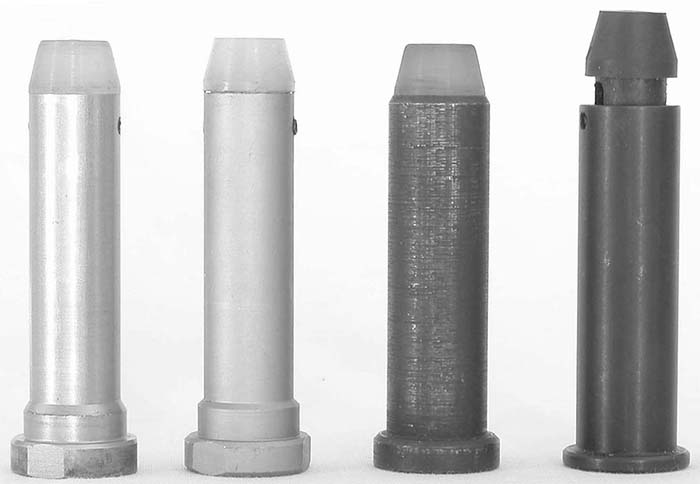The MGI Rate Reducing Buffer was designed to function in any firearm in the M16 family regardless of stock type or barrel length.
by Jeff W. Zimba
This latest project from MGI is a drop-in unit requiring no tools or additional modification to the firearm; it simply replaces the factory buffer. It is used in conjunction with the factory buffer spring and is not a hydraulic unit, but a mechanical device. As the factory recoil spring is utilized, there is no loss of reliability as a consequence of a weakened charging mechanism use to retard the rate of fire.
The buffer is self-adjusting and will reduce cyclic rate to the lowest possible rate within the parameters of acceptable reliability. The faster your M16 is to begin with, the greater the reduction in rate of fire. This system works both in carbines and in full-length rifles. If the buffer is of the shorter, carbine length, a spacer is included with it for use in a standard A1 or A2 stock.
All testing was performed with the assistance of a PACT MKIV Timer. The PACT MKIV Timer is a small computer you can clip on your belt that will count the number of rounds fired and records the overall time to provide the cyclic rate. It will also record the amount of time between each round. It can be used for competitive shooting when running through a timed course and provide a random buzzer as well. The suggested retail price is under $200.

The first test platform used was an M16 with a collapsible stock and an 11.5-inch barrel. Using standard military 5.56x45mm M193 ball ammo, the average cyclic rate with the factory buffer was 1,029 rpm. When the MGI buffer was installed the cyclic rate dropped to an average of 760 rpm. That is a reduction of 269 rpm. The largest extreme spread was a drop from 1,056 rpm to 745 rpm. That was a cold gun and the reduction was 302 rpm. Using the same gun but running Wolf 55-grain ammunition we averaged 957 rpm with the factory buffer and only 711 rpm with the MGI buffer. That was an average reduction of 246 rpm.
Next, upper receivers were swapped to utilize a 20-inch barrel. The M193 ball averaged 771 rpm with the factory buffer and dropped to 638 rpm with the MGI buffer. The average reduction in cyclic rate in this configuration is 133 rpm. The Wolf ammo averaged 707 rpm with the factory buffer and dropped to 597 rpm with the MGI buffer for an average reduction of 110 rpm.

The third set of tests performed was with a 16-inch barrel chambered in 7.62x39mm. Standard Chicom, steel-cased, Berdan-primed ball ammo was utilized. The original rate of fire with a factory 5.56x45mm buffer averaged 872 rpm. Switching to the MGI buffer dropped the cyclic rate to an average of 685 rpm. That was a decrease in the cyclic rate of 187 rpm. While the reduction was not as great as some of the results with 5.56x45mm ammunition something else started to become very obvious. The perceived recoil was lowered significantly and the muzzle jump was only a fraction of the rise encountered with the original buffer. While this was apparent throughout all the testing, it was more pronounced with the heavier bullet and increased recoil of the 7.62x39mm cartridge.
In order to actually get a close look at what was happening to the muzzle rise, a Nikon CP5000 camera was set up in the movie mode on a tripod. Several strings were fired with the factory buffers as well as the MGI buffer. When we got back to the studio and uploaded the videos, we played them simultaneously and the results were quite revealing. When the factory buffers were being utilized there was a moderate amount of muzzle rise. I have been shooting M16s for many years and I can hold them fairly steady during full-auto bursts. When we viewed the footage of the MGI-buffer-equipped weapons the results were startling. I took a few of these videos, strung them together and uploaded them onto the MGI website. In each video, there is a 20-round burst with a factory buffer followed by a 20-round burst with an MGI buffer. If you put your mouse pointer on the muzzle of the rifle while the video is playing, you can see that while using the standard buffer there is some movement. When the clip with the MGI buffer plays you will notice almost no movement at all. It is especially apparent when using the 20-inch barrel, as the cyclic rate is much slower than the 11.5-inch barrel. If you would like to see these for yourself follow the products link to the MGI Buffer System from the main page at www.mgimilitary.com.

The MGI buffer was tested next with a 9x19mm SMG upper receiver. An 11.5-inch, barreled upper receiver and a Colt-style magazine block were purchased from J&T Distributing. A J&T 9x19mm upper receiver was chosen because it is similar to the original Colt design and uses the standard Colt 9mm magazines. It also permits use of the factory magazine/catch release. While the system runs fine with modified Uzi magazines the testing was performed with original Colt 20-round magazines due to their reputation for reliability. The first string of testing was with the original 5.56x45mm buffer. The average rate of fire was 830 rpm. When the heavy 9mm buffer from J&T was installed, the cyclic rate dropped to 663 rpm. This buffer was replaced by the MGI buffer and the cyclic rate dropped to an average of 622 rpm. All of these 9x19mm tests were duplicated while using a Gemtech 9mm 3-lug adapter and an AWC Minitac suppressor to test the effects the suppressor would have on the cyclic rate, but the results were inconclusive. While the gun functioned well with all three buffers, the sound pressure level was lowered to the extent that the PACT Timer could no longer register every round being fired, yielding false results. Some times it would even count “extra” rounds from the SNAP of the bullet hitting the impact area.
As the 11.5-inch-barreled, 5.56x45mm system had the fastest cyclic rate, as well as the greatest level of reduction in the rate of fire, it was chosen for use during the accuracy testing in fully-auto fire. This was obviously the least controllable platform. All testing thus far has been conducted at 25 yards while shooting a full 20-round magazine in one burst. While not practical in a tactical environment, we felt would provide the greatest test of the actual recoil reduction. Our expectations were confirmed and the hit probability was increased by at least 50% after removing the factory buffer and installing the MGI buffer.
Because of range limitations, we did not test fire in vertical directions. In combat there are sometimes requirements for firing up (Snipers in trees or buildings), or firing down (From helicopter or building). There might be changes in the rate of fire or reliability in those scenarios.
Conclusions
Test firing was conducted in temperatures ranging from over 90ºF to as cold as -5ºF below zero. Functioning was not affected with any buffer used and the reliability remained the same. In every test performed, the cyclic rate was consistently reduced and the recoil spike was cut drastically when the MGI buffer was utilized. Muzzle rise was almost completely eliminated in some of the rifles with longer barrels and was cut significantly in all configurations. In both long and short bursts the hit probability was increased due to the additional controllability. In full-auto, smaller bursts could be fired solely by using a disciplined trigger control with the MGI buffer installed as a result of the significantly reduced cyclic rates. I can recommend the MGI Rate Reducing Buffer without reservations of any kind.
Sources
Rate Reducing M16 Buffer
MGI
Dept. SAR
P.O. Box 61
Levant, ME 04456
(207)884-8226
www.mgimilitary.com
Wolf 5.56 Ammunition
WOLF Ammunition
Dept. SAR
2201 E. Winston
Suite K
Anaheim, CA 92806
(714)635-4246
www.wolfammo.com
9mm 3-Lug Barrel Adapter
Gemtech
Dept. SAR
P.O. Box 140618
Boise, ID 83714
(208)939-7222
www.gem-tech.com
Minitac Suppressor
AWC Systems Technology
Dept. SAR
P.O. Box 41938
Phoenix, AZ 85080
(623)780-1050
www.awcsystech.com
MKIV Pact Timer
PACT
Dept. SAR
P.O. Box 535025
Grand Prairie, TX 75053
(800)722-8462
www.pact.com
9mm M16 Upper Receivers
J&T Distributing
Dept. SAR
Box 430
Winchester, KY 40391
(859)745-1757
www.jtdistributing.com
| This article first appeared in Small Arms Review V7N8 (May 2004) |











